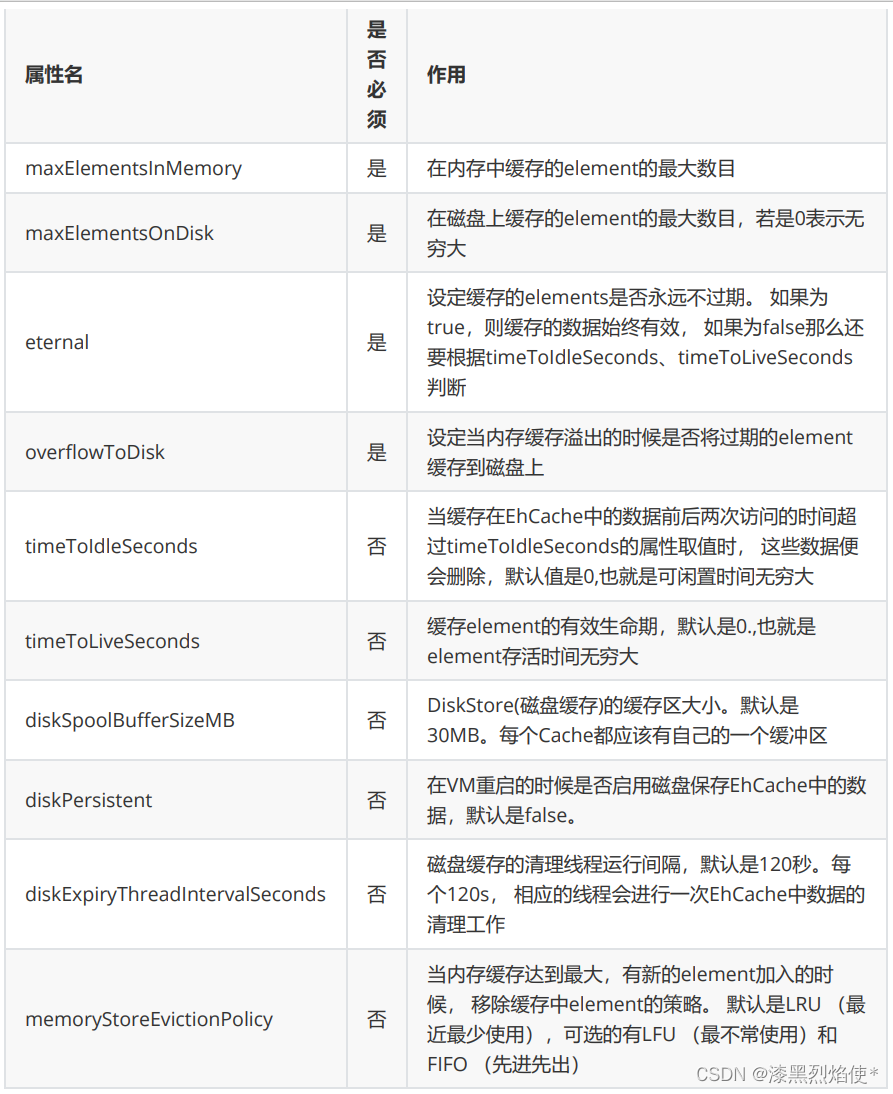MyBatis缓存
MyBatis中的缓存主要针对查询功能,可以将查询出来的数据进行缓存,等待下次查询相同数据时就不需要向数据再发送请求
MyBatis的一级缓存
一级缓存是SqlSession级别的,通过同一个SqlSession查询的数据会被缓存,下次查询相同的数据,就会从缓存中直接获取,不会从数据库重新访问(MyBatis默认开启的)
使一级缓存失效的四种情况:
- 不同的SqlSession对应不同的一级缓存
- 同一个SqlSession但是查询条件不同
- 同一个SqlSession两次查询期间执行了任何一次增删改操作
- 同一个SqlSession两次查询期间手动清空了缓存(
sqlSession.clearCache())
MyBatisTest.java
@Test
public void deptSelect(){
SqlSession sqlSession = SqlSessionUtils.getSqlSession();
DeptMapper deptMapper = sqlSession.getMapper(DeptMapper.class);
Dept dept = deptMapper.getDeptAndEmp(10);
System.out.println(dept);
//同一个SqlSession对象,且在查询前没有进行增删改,所以第二次查询使用的缓存
Dept dept1 = deptMapper.getDeptAndEmp(10);
System.out.println(dept1);
//这里创建了另外一个SqlSession对象
SqlSession sqlSession1 = SqlSessionUtils.getSqlSession();
DeptMapper deptMapper1 = sqlSession1.getMapper(DeptMapper.class);
Dept dept2 = deptMapper1.getDeptAndEmp(10);
System.out.println(dept2);
}
DEBUG 01-13 16:06:06,618 ==> Preparing: select t_dept.dept_name,t_emp.* from t_dept join t_emp on t_dept.dept_id = t_emp.dept_id where t_dept.dept_id = ? (BaseJdbcLogger.java:137)
DEBUG 01-13 16:06:06,665 ==> Parameters: 10(Integer) (BaseJdbcLogger.java:137)
DEBUG 01-13 16:06:06,696 <== Total: 2 (BaseJdbcLogger.java:137)
Dept{deptId=10, deptName='管理部门', emps=[Emp{empId=1, empName='yu', gender='男', dept=null}, Emp{empId=2, empName='xuan', gender='男', dept=null}]}
Dept{deptId=10, deptName='管理部门', emps=[Emp{empId=1, empName='yu', gender='男', dept=null}, Emp{empId=2, empName='xuan', gender='男', dept=null}]}
DEBUG 01-13 16:06:06,805 ==> Preparing: select t_dept.dept_name,t_emp.* from t_dept join t_emp on t_dept.dept_id = t_emp.dept_id where t_dept.dept_id = ? (BaseJdbcLogger.java:137)
DEBUG 01-13 16:06:06,805 ==> Parameters: 10(Integer) (BaseJdbcLogger.java:137)
DEBUG 01-13 16:06:06,821 <== Total: 2 (BaseJdbcLogger.java:137)
Dept{deptId=10, deptName='管理部门', emps=[Emp{empId=1, empName='yu', gender='男', dept=null}, Emp{empId=2, empName='xuan', gender='男', dept=null}]}
MyBatis的二级缓存
二级缓存是SqlSessionFactory级别,通过同一个SqlSessionFactory创建的SqlSession查询的结果会被缓存。此后若再次执行相同的查询语句,结果就会从缓存中获取
二级缓存开启的条件:
- 核心配置文件中,设置全局配置属性cacheEnabled=“true”,默认为true,不需要设置
- 在映射文件中设置标签(
<cache></cache>) - 二级缓存必须在SqlSession关闭或提交之后有效(
sqlSession.close()) - 查询的数据所转换的实体类类型必须实现序列化的接口(JavaBean实现
implement Serializable)
使二级缓存失效的情况:
- 两次查询之间执行了任意的增删改,会使一级和二级缓存同时失效
Dept.java
//存在的属性所对应的JavaBean——Emp也需要实现接口
public class Dept implements Serializable {
DeptMapper.xml
<!--开启二级缓存-->
<cache></cache>
MyBatisTest.java
@Test
public void testCache() throws IOException {
//读取MyBatis的核心配置文件的输入流
InputStream is = Resources.getResourceAsStream("mybatis-config.xml");
//获取SqlSessionFactoryBuilder对象
SqlSessionFactoryBuilder sqlSessionFactoryBuilder = new SqlSessionFactoryBuilder();
//根据核心配置文件的输入流创建工厂类SqlSessionFactory,来生产sql的会话对象SqlSession对象
SqlSessionFactory sqlSessionFactory = sqlSessionFactoryBuilder.build(is);
//生产SqlSession对象-->是mybatis提供的操作数据库的对象
SqlSession sqlSession = sqlSessionFactory.openSession(true);//这里参数填"true"就可以实现自动提交事务
//创建两个同一SqlSessionFactory生产的SqlSession对象
SqlSession sqlSession1 = sqlSessionFactory.openSession(true);
DeptMapper deptMapper = sqlSession.getMapper(DeptMapper.class);
Dept dept = deptMapper.getDeptAndEmp(10);
System.out.println(dept);
//关闭sqlSession后从一级缓存存入二级缓存
sqlSession.close();
//这里创建了另外一个SqlSession对象,但是是同一个SqlSessionFactory
DeptMapper deptMapper1 = sqlSession1.getMapper(DeptMapper.class);
Dept dept1 = deptMapper1.getDeptAndEmp(10);
System.out.println(dept1);
sqlSession1.close();
}
DEBUG 01-13 16:41:19,526 Cache Hit Ratio [com.atguigu.mybatis.mapper.DeptMapper]: 0.0 (LoggingCache.java:60)
DEBUG 01-13 16:41:21,105 ==> Preparing: select t_dept.dept_name,t_emp.* from t_dept join t_emp on t_dept.dept_id = t_emp.dept_id where t_dept.dept_id = ? (BaseJdbcLogger.java:137)
DEBUG 01-13 16:41:21,136 ==> Parameters: 10(Integer) (BaseJdbcLogger.java:137)
DEBUG 01-13 16:41:21,167 <== Total: 2 (BaseJdbcLogger.java:137)
Dept{deptId=10, deptName='管理部门', emps=[Emp{empId=1, empName='yu', gender='男', dept=null}, Emp{empId=2, empName='xuan', gender='男', dept=null}]}
WARN 01-13 16:41:21,183 As you are using functionality that deserializes object streams, it is recommended to define the JEP-290 serial filter. Please refer to https://docs.oracle.com/pls/topic/lookup?ctx=javase15&id=GUID-8296D8E8-2B93-4B9A-856E-0A65AF9B8C66 (SerialFilterChecker.java:46)
DEBUG 01-13 16:41:21,183 Cache Hit Ratio [com.atguigu.mybatis.mapper.DeptMapper]: 0.5 (LoggingCache.java:60)
Dept{deptId=10, deptName='管理部门', emps=[Emp{empId=1, empName='yu', gender='男', dept=null}, Emp{empId=2, empName='xuan', gender='男', dept=null}]}
二级缓存的相关配置
在mapper配置文件中添加的cache标签可以设置一些属性:
①eviction属性:缓存回收策略,默认的是 LRU
-
LRU(Least Recently Used) – 最近最少使用的:移除最长时间不被使用的对象
-
FIFO(First in First out) – 先进先出:按对象进入缓存的顺序来移除它们
-
SOFT – 软引用:移除基于垃圾回收器状态和软引用规则的对象
-
WEAK – 弱引用:更积极地移除基于垃圾收集器状态和弱引用规则的对象
②flushInterval属性:刷新间隔,单位毫秒
- 默认情况是不设置,也就是没有刷新间隔,缓存仅仅调用语句时刷新
③size属性:引用数目,正整数
- 代表缓存最多可以存储多少个对象,太大容易导致内存溢出
④readOnly属性:只读, true/false
- true:只读缓存;会给所有调用者返回缓存对象的相同实例。因此这些对象不能被修改。这提供了很重要的性能优势。
- false:读写缓存;会返回缓存对象的拷贝(通过序列化)。这会慢一些,但是安全,因此默认是false
MyBatis缓存查询顺序
- 先查询二级缓存,因为二级缓存中可能会有其他程序已经查出来的数据,可以拿来直接使用。
- 如果二级缓存没有命中,再查询一级缓存
- 如果一级缓存也没有命中,则查询数据库
- 如果二级缓存没有命中,再查询一级缓存
SqlSession关闭之后,一级缓存中的数据会写入二级缓存
整合第三方缓存EHCache
MyBatis的二级缓存可以使用第三方缓存进行整合和管理
添加依赖
pom.xml
<!-- Mybatis EHCache整合包 -->
<dependency>
<groupId>org.mybatis.caches</groupId>
<artifactId>mybatis-ehcache</artifactId>
<version>1.2.1</version>
</dependency>
<!-- slf4j日志门面的一个具体实现 -->
<dependency>
<groupId>ch.qos.logback</groupId>
<artifactId>logback-classic</artifactId>
<version>1.2.3</version>
</dependency>
各jar包功能
| jar包名称 | 作用 |
|---|---|
| mybatis-ehcache | Mybatis和EHCache的整合包 |
| ehcache | EHCache核心包 |
| slf4j-api | SLF4J日志门面包 |
| logback-classic | 支持SLF4J门面接口的一个具体实现 |
创建EHCache的配置文件ehcache.xml
在resources目录下创建ehcache.xml
<?xml version="1.0" encoding="utf-8" ?>
<ehcache xmlns:xsi="http://www.w3.org/2001/XMLSchema-instance"
xsi:noNamespaceSchemaLocation="../config/ehcache.xsd">
<!-- 磁盘保存路径(按需修改) -->
<diskStore path="D:\atguigu\ehcache"/>
<defaultCache
maxElementsInMemory="1000"
maxElementsOnDisk="10000000"
eternal="false"
overflowToDisk="true"
timeToIdleSeconds="120"
timeToLiveSeconds="120"
diskExpiryThreadIntervalSeconds="120"
memoryStoreEvictionPolicy="LRU">
</defaultCache>
</ehcache>
EHCache配置文件说明

设置二级缓存的类型
在Mapper.xml文件中需要对使用的二级缓存进行声明,否则就会使用MyBatis默认的二级缓存
<!-- 不需要修改 -->
<cache type="org.mybatis.caches.ehcache.EhcacheCache"/>
加入logback日志
存在SLF4J时,作为简易日志的log4j将失效,此时我们需要借助SLF4J的具体实现logback来打印日 志。 创建logback的配置文件logback.xml
在resources目录下创建logback.xml
<?xml version="1.0" encoding="UTF-8"?>
<configuration debug="true">
<!-- 指定日志输出的位置 -->
<appender name="STDOUT" class="ch.qos.logback.core.ConsoleAppender">
<encoder>
<!-- 日志输出的格式 -->
<!-- 按照顺序分别是: 时间、日志级别、线程名称、打印日志的类、日志主体内容、换行-->
<pattern>[%d{HH:mm:ss.SSS}] [%-5level] [%thread] [%logger]
[%msg]%n</pattern>
</encoder>
</appender>
<!-- 设置全局日志级别。日志级别按顺序分别是: DEBUG、INFO、WARN、ERROR -->
<!-- 指定任何一个日志级别都只打印当前级别和后面级别的日志。 -->
<root level="DEBUG">
<!-- 指定打印日志的appender,这里通过“STDOUT”引用了前面配置的appender -->
<appender-ref ref="STDOUT" />
</root>
<!-- 根据特殊需求指定局部日志级别(按需修改) -->
<logger name="com.atguigu.crowd.mapper" level="DEBUG"/>
</configuration>






















 4216
4216











 被折叠的 条评论
为什么被折叠?
被折叠的 条评论
为什么被折叠?








